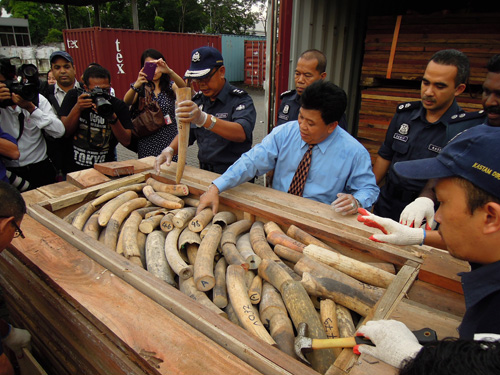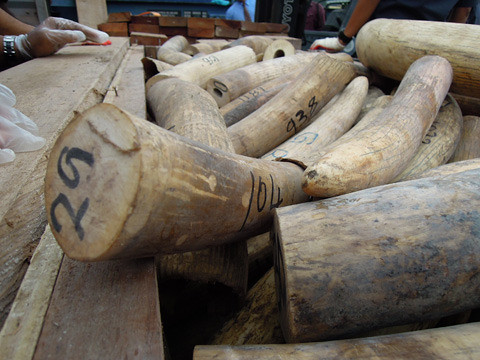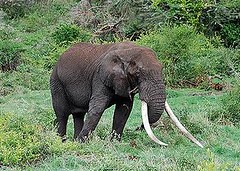馬來西亞皇家海關(Royal Malaysian Customs)11日宣布查獲歷來最大的象牙走私案件, 1500根象牙藏在看起來像木材的箱內。

這批象牙是從西非國家多哥(Togo)的洛美港(port of Lomé)運來,分裝在兩貨櫃中的10個木箱內。雪蘭莪州(Selangor)海關主管拿督Azis Yacub召開記者會表示,該些象牙原先預計送至中國。
該船曾經過西班牙的阿爾赫西拉斯(Algeciras),而後抵達巴生港(Port Klang)西港。巴生港為馬來西亞半島上最繁忙的貨櫃碼頭之一,位於首都吉隆坡市郊。
表面上是裝載「桃花心木地板」的兩個貨櫃,7日在巴生港被扣留,並在10日晚間開箱檢查。海關人員在移開頂層的箱子後,發現象牙放置在一個深一米左右的隱藏隔間中。
馬來西亞皇家海關人員估計,這批龐大的走私象牙可能重達20至24噸。

一家總部設於巴生港的馬來西亞公司,正在接受調查與走私象牙間的關係。如果罪名成立,該公司可能面臨高達500,000馬幣(163,500美元)的罰款,或個人5年以下有期徒刑,亦或兩者。
Azis呼籲大眾應與海關當局保持聯繫,以杜絕走私象牙。他承諾,會對檢舉人的身份進行保密,且若所提供資訊成功起訴,更將有金錢上的獎勵。
眾所皆之,多哥是象牙流出非洲的主要源頭。雖然該國經常與查獲走私有關,但卻從未提報案件至「大象貿易信息系統」(Elephant Trade Information System, ETIS)。該系統是由野生物監控組織「國際野生物貿易研究委員會」(TRAFFIC)代表華盛頓公約組織(CITES)所管理。
TRAFFIC鼓勵所有與該走私案有所牽連國家徹底調查,讓走私貨品都可找回。並將犯罪者繩之以法。
自2011年7月以來,這是第四次有非洲象牙在巴生港被扣押,同時也是馬國查獲的第六次。
 英國保育機構「生而自由基金會」(Born Free Foundation)執行長Will Travers表示,「去年,2011年,被貿易專家稱為大象生存數十年來最糟糕的一年。」而他補充道,許多大型走私案件使這些血淋淋的象牙貿易在 2012年達到更糟的程度,亦更為腐化。
英國保育機構「生而自由基金會」(Born Free Foundation)執行長Will Travers表示,「去年,2011年,被貿易專家稱為大象生存數十年來最糟糕的一年。」而他補充道,許多大型走私案件使這些血淋淋的象牙貿易在 2012年達到更糟的程度,亦更為腐化。
今年,海關人員5月在斯里蘭卡(Sri Lanka)的科倫坡查獲1.5噸的走私象牙(Colombo);7月在紐約查到約一噸;在香港查兩批,分別是10月3.8噸與11月的1.33噸;除這些外,尚有其他走私案件。
貪圖中國象牙市場 非法獵象層出不窮
據估計,每年有兩萬至三萬頭非洲象被非法捕殺,已滿足需求,而主要的市場乃是中國。
Travers 表示,非洲沒有一處是安全的。這是第一次,整個非洲大陸盜獵死亡的大象數量已經超過了自然死亡。且在不久的將來,情況可能會變得更糟。
在距下次華盛頓公約176個締約方會議只有3個月的時候,坦尚尼亞(Tanzania)正試圖出售超過100噸的庫存象牙至中國和日本。
「生而自由基金會」創辦人Virginia McKenna表示,「我害怕大象將會從非洲那些最危險、最沒有保障的地方永遠消失。」西非和中非的大象族群最為脆弱,但即便像肯亞野生動物管理局 (Kenya Wildlife Service)的巡守員訓練有素、資源充足,亦在全力捍衛大象時,失去了生命。
在非洲執行保育工作多年的生而自由基金會連同其他保育團體,要求坦尚尼亞收回成命,呼籲中國和日本等象牙貿易國家收回要求。呼籲國際社會前來資助非洲大象行動計劃 (African Elephant Action Plan),此乃分布廣達37國之非洲象的唯一生存藍圖。
Royal Malaysian Customs today announced their largest ivory seizure ever, a find of 1,500 pieces of elephant tusks hidden in wooden crates built to look like stacks of sawn timber.
The ivory, hidden in 10 crates divided between two containers, was shipped from the port of Lomé in the West African country of Togo. It was headed to China, the Selangor State Customs Director Dato’ Azis Yacub told reporters at a news conference today.
The shipment transited through Algeciras, Spain before it headed for West Port in Port Klang, one of peninsular Malaysia’s busiest container terminals, situated just outside Malaysia’s capital of Kuala Lumpur.
The two containers, declared to be carrying “wooden floor tiles acajou,” were held at Port Klang on December 7 and inspected Monday night. After removing the top layer of the crates, customs officers found the ivory in a secret compartment measuring about one meter deep.
Royal Malaysian Customs officials estimate the weight of this giant seizure at between 20 and 24 tonnes.
A Malaysian company based at Port Klang is being investigated in connection with the ivory seizure. If convicted, the company could face up to RM500,000 (US$163,500) in fines and individuals a maximum of five years in jail, or both.
Azis called on the public to continue providing the customs department with information that would help them stop ivory smuggling. He promised that the identities of informants would be kept confidential and a financial reward would be paid if their information led to a successful prosecution.
Togo is known to be a major source of ivory exiting Africa. The country is regularly implicated in reported seizures although it has never reported a seizure to the Elephant Trade Information System, managed by the wildlife monitoring organization TRAFFIC on behalf of Parties to the Convention on International Trade in Endangered Species, CITES.
TRAFFIC is encouraging all the countries implicated in the seizure to investigate this case thoroughly, so that those behind the shipment can be traced and brought to justice.
This is the fourth seizure of African elephant ivory at Port Klang and the sixth in the country since July 2011.
“Last year, 2011, was described by trade experts as the worst year for elephants in decades” said Will Travers, CEO of the UK conservation charity Born Free Foundation, adding that the many large seizures made this year means “the bloody ivory trade has reached new heights of destruction and depravity in 2012.”
This year customs officials seized 1.5 tonnes of smuggled ivory in Colombo, Sri Lanka in May; just under one tonne in New York in July; and two shipments in Hong Kong – one of 3.8 tonnes in October and another of 1.33 tonnes in November, among other seizures.
Experts estimate that between 20,000 and 30,000 African elephants are being illegally killed each year to fuel demand, primarily driven by China.
“No part of Africa is now safe,” said Travers. “Across the continent, for the first time, the number of [elephant] carcasses recorded as a result of poaching exceeds the number reportedly dying from natural causes.”
And the situation could get worse in the near future.
With only three months until the next meeting of 176 Parties to the CITES Convention, Tanzania is seeking approval for the sale of more than 100 tonnes of stockpiled ivory to China and Japan.
“I fear that elephants may disappear entirely from those parts of Africa least able to protect them from the onslaught,” said Virginia McKenna, founder of the Born Free Foundation. “The fragile elephant populations of West and Central Africa are most at risk, but even countries such as Kenya, with the well-trained and well-resourced rangers of the Kenya Wildlife Service, are operating at full stretch and losing their lives in the process.”
Born Free, together with other conservation charities with many years of experience working in Africa, are asking Tanzania to withdraw its proposal. They are calling for China and Japan’s status as ivory trading nations to be revoked and for the international community to come forward with the resources necessary to fund the African Elephant Action Plan, the only blueprint for elephant survival agreed by all 37 African elephant range states.
※ 全文及圖片詳見:ENS

